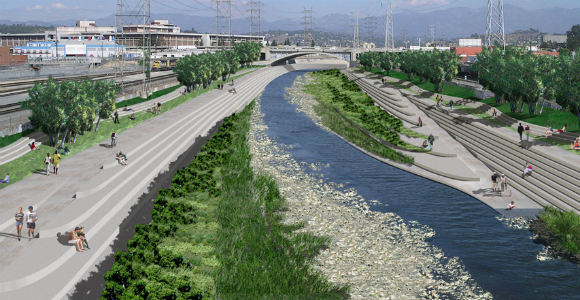
Rendering of L.A. River restoration project. (Photo Credit: LARRMP)
Update December 5, 2016:
The potential for a new infrastructure funding tool to revitalize the Los Angeles River was presented to the City of Los Angeles' Arts, Parks, and Los Angeles River Committee today. The Enhanced Infrastructure Financing District (EIFD) tool could help gather millions in funds for improvements along a 32-mile stretch of the River.
“An EIFD is not a new tax,” said Councilmember Mitch O’Farrell. “The monies collected for the Los Angeles River will help us reach our goal of improving the River environment, including habitat restoration, infrastructure improvements, and of equal importance, it will generate revenue for the production of affordable housing. The affordable housing component is key to building broad support for this plan because we must support policy initiatives that will help combat the displacement crises facing this city. This funding tool will help the City realize our vision for the LA River corridor over the next several decades, and I look forward to the continued discussion on this topic in the coming months.”
Click here to read the presentation.
———————-
When news broke that Senate Bill 628 passed the California Legislature, one Los Angeles City Councilmember was thinking, “I sure hope Governor Brown signs it.”
Mitch O'Farrell shared that memory with CAeconomy.org recently as he was talking about efforts to have the state's first-ever Enhanced Infrastructure Financing District (EIFD) created in the city of Los Angeles.
O'Farrell thinks this newly enacted piece of local governance authority can help a major City priority, revitalizing the Los Angeles River, become a reality by helping fund restoration and improvement projects on a 31-mile portion of the river. Last year, the Army Corps of Engineers agreed to a $1-billion restoration plan, but it required city funding.
Creating an EIFD might be just the answer because it allows more property taxes within in the city to be retained. The City of L.A. will take a look at the idea and report back in less than two months.
“We congratulate Councilmember O'Farrell for pushing this idea,” said Mark Pisano, former executive director of the Southern California Association of Governments and nationally known infrastructure expert and co-chair of the Infrastructure Working Group of California Forward, which helped draft the bill. “The L.A. River project is exactly what the law envisioned to give areas that have economic development potential and infrastructure needs the power to create an organizational structure to get parties organized and working toward a common goal and provided legal authority to enact the needed funding tools.”
The idea for an EIFD was a high priority of the California Economic Summit, which pushed the idea as a way for California to begin to address the need for infrastructure investment. California's infrastructure deficit has been consistently rated as a top economic need if California is going to create more middle class jobs and protect the state's ranking as a global economic power.
The EIFD public finance authority gives cities the power to better leverage state funds for infrastructure projects.
“The state doesn't just hand out money for infrastructure projects,” said CA Fwd's senior fiscal analyst, Fred Silva. “It has policy preferences and ask for some local contributions through growth in the local economy. The EIFD helps meet that requirement.”
While the law allows other affected taxing agencies to be part of a public finance authority, O'Farrell is prepared for L.A. to go this alone. Conversations will be held with L.A. County and others, which actually could expand the project, but that capability is not necessary for what L.A. is talking about doing with the River.
Creating an EIFD is easier for local governments to do. The new law created the flexibility by including the following provisions:
- Forming an EIFD would not require the current two-thirds voter approval. Once a district is established, it can use a range of financial tools without further voter approval. Only when public debt is sought would a 55 percent vote be required.
- Expands financing authority: The new EIFD allows local leaders to support infrastructure projects through multiple funding streams, as well as private investment and procurement.
- Increases investment in different types of infrastructure: In addition to a water project, like the L.A. River, transportation, public facilities, and energy are among the infrastructure areas that could be positively impacted.
- Allows more flexible institutional collaborations: As this project indicates, communities gain more flexibility to accommodate regional growth by making infrastructure investment across jurisdictions through the new Public Finance Authorities.
Pisano, who is currently a Professor of the Practice of Public Administration at the University of Southern California, thinks the new California law has national implications.
“This is the best thought-out piece of state legislation in the country,” he said. “This enables local and regional leaders to bring projects to the table that previously just couldn't get done.”
L.A. Councilmember O'Farrell also sees the potential. “There are other possible projects in the city where Community Redevelopment Agencies were dissolved where EIFD's could be valuable,” said O'Farrell.
Those can wait because for now, the focus of this first effort to create an EIFD in California is aimed solely at what O'Farrell, L.A. Mayor Eric Garcetti and other local leaders hope is a way to jump start the L.A. River project.
For a very good summary on how the EIFDs can help fill the state's infrastructure gap, read our story ” New tool may aid California cities in filling state’s infrastructure gap” which has a link to a recent webinar on EIFDs.
For a copy of the California Economic Summit's Roadmap to Shared Prosperity, which includes more steps to help build additional infrastructure in the state, click here.

